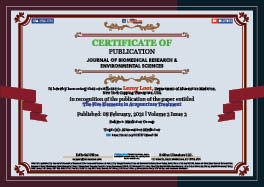> Medicine Group. 2021 Feb 16;2(2):042-043. doi: 10.37871/jbres1186.
The Five Elements in Acupuncture Treatment
Leroy Loot*
The Five Elements in acupuncture treatment is determined by using various sequences and the Five Transporting points simultaneously.
The Five Elements
The Five elements of Chinese Medicine consist of Fire, Earth, Metal, Water, and Wood. Within Chinese Medicine theory, different organs are connected to the different elements.
- The heart and small intestine are connected to Fire
- The spleen and stomach are connected to Earth
- The lungs and large intestine are connected to Metal
- The kidneys and bladder are connected to Water
- The liver and gallbladder are connected to Wood
Treatment according to Sequences
When considering a treatment of a certain Element, one should keep in mind the relationships of that Element through the Generating, Controlling, Over-acting, Insulting and Cosmological sequences.
- Is the disharmony caused by another element, and is it causing disharmony in another element?
- Is the mother element at fault? Or is the child consuming more than it should?
- Is the element being insulted or is it insulting?
- What are the symptoms indicating?
The Five Transporting Points
Within the joints of the fingers, elbows, toes and knees are points called The Five Transporting points. Each of these points connect to a channel, starting from Yin (Wood) to Yang (Metal) in the Generating sequence.
In the book ‘Classic of Difficulties’ by Nan Jing chapter 69 states: ‘In case of Deficiency, tonify the Mother, in case of Excess sedate the Child’.
If an organ is deficient, the point connected to the channel of the mother element is pressed to tonify the mother.
- In the case of Lung deficiency, the point pressed would be the one on the Lung channel connected to the mother element, the Spleen, according to the generating sequence.
If the organ is in excess, meaning it is taking too much from the mother element, the point connected to its child element is pressed to tonify the child.
- In the case of Lung excess, the point pressed would be the one on the Lung channel connected to the child element, the Kidneys, according to the generating sequence.
Ultimately, the Five Element Points could remove pathogenic factors. Fire is to heat, wood is to wind, Earth is to dampness, metal is to dryness, water is to cold. An element point could be used to subdue its characteristic, such as using the fire points to subdue heat or using a metal point to clear dryness.
Herbal and Diet Therapy
An extensive part of Chinese medicine is diet therapy and is fairly similar to that of herbal therapy. Elements have specific tastes relating to them as does each food and herb.
The taste considers the intrinsic quality than actual flavor and each has a different impact in the body:
The sour taste: creates fluids and Yin that can control perspiration and diarrhea.
The bitter taste: removes Heat, clears Damp-Heat and it controls rebellious Qi.
The sweet taste: tonifies deficiency, balances, and moderates; used to stop pain.
The sweetness enhances muscles, but an excess can cause weakness.
The pungent taste: scatters Qi expels pathogenic factors, but it should be avoided in Qi deficiency
The salty taste: Treats constipation and swelling as it flows down, softens and hardness.
Diets should not contain this taste in blood deficiency because it dries up Blood.
The sour taste: goes to the nerves, however an excess disturbs the Liver
The bitter taste: benefits the bones, but an excess should be avoided in bone diseases.
An excess of everything will cause imbalance in targeted areas of the body. Excess taste from one element may lead to deficiency in other organs. In a case in which the lung is affected (Metal), the taste would be pungent. One would have to avoid foods that are pungent if there is excess. It would be the opposite if the patient is experiencing deficiency.
If an organ is diseased, the taste of its controlling element within the controlling sequence should not be eaten:
- The sour taste goes to the Liver
- The bitter taste goes to the Heart
- The sweet taste goes to the Spleen
- The pungent taste goes to the Lungs
- The salty taste goes to the Kidneys
Patients should avoid bitter tastes for excess in Fire organs, sweet tastes for excess in Earth organs, pungent tastes for excess in Metal organs, salty tastes for excess in Water organs, and sour for excess in Wood organs.
If the Heart is diseased, the diet should not contain salty foods because the Kidneys control the heart. Alternatively, to nourish the organ the taste connected to the organ it controls should be consumed. If the heart needs nourishment, the diet should contain pungent tastes because the lungs control the heart.
In the case of lung excess the element that would be considered is the Metal element. When diagnosing a patient who is experiencing excess or deficiency with the lungs and large intestine Chinese Medicine Theory correlates that element along with its organ. One must consume all tastes in order to balance all elements throughout the body.
To learn more about acupuncture and Chinese medicine, visit the YouTube channel “Acupuncture is my Life”.
Content Alerts
SignUp to our
Content alerts.
 This work is licensed under a Creative Commons Attribution 4.0 International License.
This work is licensed under a Creative Commons Attribution 4.0 International License.








